
#tbt Caruthersville School District #18 wasn’t able to publish yearbooks for various reasons between 1923 and 1950. Featuring classes with a ‘3’ this year, this week is the Class of 1933 (taken from the composite pictures now residing in the Pemiscot County Historic Society room at Caruthersville Public Library. These composites hung at the high school for many years, but it is great that the school district is allowing the PCHS to house them.)
Names from top to bottom and columns from left to right are: Truman Mayfield, Gladys Swift, Gus McAlister, Julia Catherine Corbett, Lilbourn Lewis, and Lorene Killett. On the ‘9″ from top to bottom are: Dollie Robinson, Mary Sue James, Hugh Tisdadt, Jr., Martha McElvain, Jay Johnston, Jr., Chester Butler, John Hosler, Jr., Rex Tutt, Carmen Baker, and Jack Reeves. On the first ‘3’ from top to bottom are: Dalton Teroy, Juanita Carey, Clinton Thompson, Jack Garrett, Bernice Chilton, Charles Holmes, Henry Tipton, Josephine Nations, and Glendora Reed. On the second ‘3’ from top to bottom are: Lavern Davis, Leeds Butler, Madge Turner, Joe B. Henley, Mary Lucille DeReign, William Pery, Cora Mae Campton, Claude Vickers, Jr., and Osborn McAdams. (Not pictured were: Wilma Adams, Frank Bruce,W. F. Moore, Julian Wood, and Richard Watkins)
Check this out for members of your own family.

#tbt A picture of the Deering schoolhouse which served all grades. It was built around 1909 and had two rooms. Later, another room was added on the north side. It was located in the northeast corner of town. This picture was taken in 1915. At that time, students desiring more education than could be offered to them at that school had to catch the train each morning and go to either Hayti or Caruthersville, returning home in the afternoon via train. Then the brick (two story) building was built and Deering had its first graduating class in 1927. This school building burned around 1940.

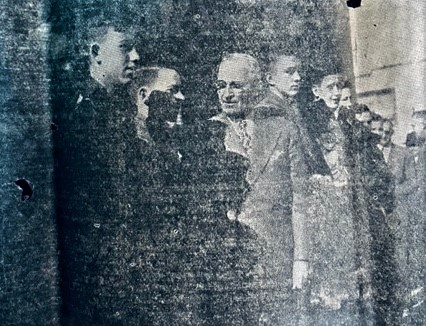
#tbt From the October 12, 1945 issue of The Democrat-Argus comes President Truman’s visit to the Pemiscot County Fair as a sitting president, though he had visited several times before.
President Truman began his Sunday attending services at the First Baptist Church, where the pastor Rev. D. K. Foster, his long-time friend, delivered the morning sermon. (The President was accompanied by U. S. Senator Frank Briggs and Governor Phil M. Donnelley.)
The first photo here shows President Truman descending the stairway at the Majestic Hotel for dinner, showing his usual smile for admirers in the lobby. Accompanying him is N. W. Helm, a close friend of Mr. Truman, who was with him most of the time during his stay here.
It is not often that a Boy Scout, even an Eagle Scout, has the honor of receiving his badge from the President of the United States. Shown in the second picture is the group of Eagle Scouts from Caruthersville and Hayti (from left) Charles McDaniel of Hayti, Robert Patterson, Bobby Joplin, Jack Allen, Billy Acuff, Lee Dorroh, Bobbie McCoy, and Harold Nance of Caruthersville. After reviewing the group, President Truman pinned his badge, recently awarded him, on the shirt of Eagle Bobby Joplin. Also in the Eagle Scout group, but not shown in the picture were Bob Tribble, Blair Buckley Jr., and Samuel Kohn of Hayti.

#tbt County clerk Edwin S. Huffman is shown here at work in the late 1910s or early 1920s in the old Pemiscot County courthouse. The present courthouse was constructed in 1924.

#tbt The Class of 1973 continues our series of featuring classes that end with a ‘3″. This class was among the largest to ever graduate from CHS and will be celebrating their 50th reunion this weekend.
Identifying these students:
Bottom row, left to right: Moses Larry, Marie Carlson, Gayla House, Steve Kuykendall, Vicki Linsman, Rickey Odle, Nancy Boyd, and Kathy Ward
Next row, left to right: Drucilla Neeley, John Turnbow, Connie Treece, William Prost, Michelle Cobb, Mike Hensley, Lettie Jean Covington, Deborah Brodie, Robert Hunter, Tippy Cagle, Lee Cooke, Lynn CookeLarry Goodale, Polly Gentry, and Jerry Pylate
Next row, left to right: Debra Baxter, Charles Cain, Gail Karwick, Susan Hardesty, Charles Dorroh, Ann Mitchum, Sherry Wilson, Terry Wicker, Anita Riggs, Donald Dodd, Mike Pierce, Daryl Young, Denise Barnett, Dwayne Clark, and Teresa Thompson
Next row, left to right: Terry Hinchey, Steve Willbanks, Deborah Pitts, Randall Holder, Dianna Morgan, Larry Meador, Helena Robinson, Eddie Terry Jr., Deborah Lee, George Cunningham, Barbara Stanfill, Leslie Knott III, Pam Snow, Jerry Simmons, and Elaine McClendon
Next row, left to right: Joyce Lockridge, Kyle Kersey, Jimmy Agnew, Cathryn Buchanan, Reggie McCarn, Diana Simmons, Johnny Harmon, Chris Crysler, Anetha Taylor, John Tutt, Jimmie Hunt, Regina Stevens, Terry Stanfill, Debbie Williams, and Danny Floyd
Center row, left to right: Don Evans, Nancy Cross, Debra Kenley, Davide Maxwell, Teresa Clayton, Luther Dawson, Billy Stewart, Rita Bullington, Robert Marshall, Dennis Taylor, and Sherry Webster
Next row, left to right: Ralph Hill, Janis Prater, Becky Taylor, Floyd Pendergrass, Eva Lantrip, Debra Abshire, Henry Timothy, Sharon Croft, Mike Rollins, Betty Robinson, Steve House, Jackie Nelson, Greg Wilson, Vicki Morgan, Johnny Ferrell, and Cindy Fox
Next row, left to right: Cynthia Teeter, Twymeter Currie, Sheila Renfroe, Charlotte Anderson, Ronnie Prater, Vicki Shelton, Pam Jean, Sammie McClorn, Gerceida Adams, Joey Parkinson, Michael Wilson, Joan Lee Lawrence, Tay Ashford, Jr., Pattie Woods, and Larry Lewis
Top row, left to right: Sandra Prather, Joe Cagle, Dennis Yarbrough, Jimmy Berry III, Linda Goodale, Larwentha Tyus, Marsha Brooks, Janet Smith, Jonnie Hayes, Tim Milum, Julia Henson, Baughn Merideth, Diana Sample, Thomas Vaughn, and Linda Tangent
(With this many pictures, it is difficult to identify them all, but this photo is on display in the Pemiscot County Historical Society room)

West End Grocery
#tbt The West-End Grocery store was located on West 6th Street and served as an important merchant for those who lived in the neighborhood for their grocery needs.
In early 1920, the proprietor Henry P. Thweatt, ran a newspaper ad saying “Try the West End Grocery for one month and see how much money you save. I want your business.” Later that year, he brought in a lady from St. Louis to teach cooking classes in the store and it was well-attended.
Beginning even in those years, neighborhoods had a number of these small “Mom and Pop” grocery stores for those who were able to walk in quickly from their homes.
As the years went by and people became more mobile and several supermarkets were opened in the city, many of these stores were closed, although a few lasted until almost 2000.
In late 1960, Mr. Wicks, the proprietor, went to the store on a routine check and discovered the wall gas furnace had overheated and was about to burst into flames, sparing a fire from getting started. Unfortunately, about ten years later, the fire shown here was unable to be extinguished with the old structure and marked the end of the store.

#tbt Another photo of the Class of 1953, taken from the high school composites that are now housed in the Pemiscot County Historical Society room at Caruthersville Public Library. All names in the photo are identified, so take a look and see if you can find any family members.
Shown here are (Top row, left to right): Mary Frances Edgerton, Kenneth King, Betty Thompson, Joe Michie, Elwanda Thrasher, Claude Gallian, Shirley Goodman, Ted Medlin, Jane Bader, and Johnny Johnson.
(Second row, left to right): Donald Angotti, Virgie Bostic, Maurice Cunningham, Charlie Mae Abbott, Joe Luten Long, and Josephine Taylor.
(Third row, left to right): Virginia Trautman, Bill Chilton, Judy Foster, Bob Trantham, James Daniel King, Barbara Shields, and Donald Barnes.
(Fourth row, left to right): Jimmy Watkins, Lavada Dunavant, Ronald Summar, Opal Hooker, Jerry Pool, Patricia Ann Morgan, Shirley Fox, Joe Aquino, Sue Mitchum, and Perry Going.
(Fifth Row, left to right): Bernice Denton, Phillip Malugen, Betty Sue Shirley, Jack King, Marlene Mallory, Darlene Mallory, Dick Richardson, Lela Jo Pankey, Bob Thrasher, and Ann Sawyer.
(Sixth row, left to right): Homer Dale Bracey, Ann Dillman, Emory Williams, Kathryn Hicks, Cecil Mae Bullington, Ronald McCoy, Carolyn Robertson, Keith Dewayne Tidwell, Maggie Hicks Bullington, and Jimmy Hill,
(Seventh row, left to right): Wilma Pease, Glenn DePriest, Marilyn Mehrle, Victor Cromer, Maxine Crowe, Earline Mott, Joseph Pattillo, Martha Wattle, Liston Walls, and June Devine.

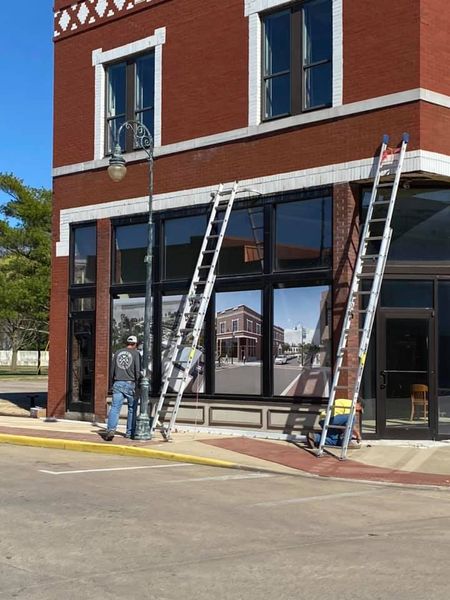

#tbt From April of 1916: A Modern two-story office building and a theater were planned at a meeting of business men held in this city Monday night. A new association known as the Exchange Building Company was formed and incorporation papers will be sought at once. It will have a capital stock of $25,000 and will include several local men as well as outside capitalists.
The plan contemplates the erection of a two-story section, facing 33×80 on Ward Avenue. The first floor will be a store room, while upstairs will be office rooms. At the rear, facing on Third Street, will be another two-story section., to be used as a modern theater and moving picture show. A stairway opening on Third Street will afford access to the upper story, comprising fifteen office rooms.
There will be a basement sufficiently large to contain a heating plant for all the building and a large supply of coal. It will be made waterproof to prevent damage by seepage.
The Exchange Building at 3rd and Ward Avenue once housed a number of offices and businesses on its second floor. The names of some of them are still etched on the doors up there – two of them being the Caruthersville School of Beauty Culture and the Jo Bay Dance Studio.
To bring this information into present-day, it has been apparent for a few years that there are plans for our Exchange Building. The Crysler family donated this building to the Caruthersville Area Arts Council and it will soon be renamed the “Crysler Exchange Building”. The Arts Council has been awarded one of 26 Missouri ARPA Tourism grants and also an ARPA Community Revitalization grant, hitting a real home-run for funding of this project. This will provide funding for the “First Domino” in the planned downtown Caruthersville Vision Plan.
The photograph of the inside of the building depicts the scope of work needing to be done, but when finished, this building will serve as a venue for local events, a local visitor center with the Chamber of Commerce, and several other things yet to be disclosed. A mural from Caruthersville’s own Gary Lucy will grace the revitalized building as well. Watch for progress to begin soon!
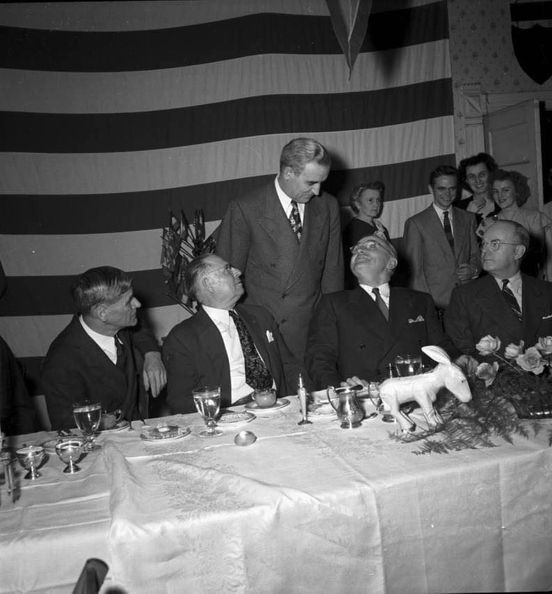










#tbt More photographs of President Harry S Truman’s visit to the American Legion Fair in October of 1945. (Thanks to Arnold Chastain in Pioneers of Pemiscot)

#tbt Until the 1960s residents had a “burn barrel”, where they would burn their refuse from their homes. As the Environmental Protection Agency (EPA) began to form regulations for clean air, the open burning was banned in the city and solid waste management became a large part of city government.
Controlled burning of derelict properties would often serve as training for fireman, but it’s rare now to be able to train fire personnel in an actual house.
Because of U.S. Environmental Protection Agency rules there’s a lot of prep work to be done before fire officials can actually burn down a house. The house has to be decontaminated by removing all of the things that will cause pollution such as tar and shingles, as well as asbestos. It takes a lot of time and expense to prep a building, as well as permits and inspections involved.
In the days when controlled burns were still a good method of training and environmentally allowed, many took place regularly in the city of Caruthersville. Here we have a photos from the late 1980s at a controlled burn. From left to right are Larry Privett, Ralph Stone, Diane Sayre, Tom Crowe, Glen Daulton, and current fire chief Charlie Jones.
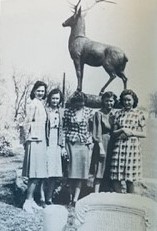
“The elk” was a well-known landmark at Little Prairie cemetery atop a tombstone on the right side near the main entrance. Strangely enough, it often served as a photo opportunity like it was here in 1942. Shown are Frances Schaffer Young, Helen DePriest Vaughn, Lillie DePriest, Marjorie Watkins Schaffer, and Dorothy DePriest Farrell.
Sadly, the elk disappeared in the middle of one night in 1994, but a local effort brought a smaller likeness of a deer to take its place, which is still atop the LaForge tombstone today.

#tbt In 1961, the Steele Igloo opened its “Teen-ager” addition. Designed to give youngsters a place to go sip a soda and skip to the tune of the latest recordings, the air-conditioned addition was 19 by 26 feet in size. Serving windows connected the new room to the original Igloo building.

#tbt From the Hayti High School “Pemiscovian” yearbook from 1916, we have a very interesting club – the School Savings Bank.
In October of 1912, Hayti school organized a savings bank and called it the Hayti School Savings Bank. Banking hours were from 9-10 each morning and any amount might be deposited, from one cent up. At the close of the day, this money was deposited by the cashier in the Bank of Hayti. At the close of the school term, each child drew out his deposits, as the bank was closed during vacation.
“Students have shown great interest in the bank and every child is now studying the meaning of the bank to him. They are learning banking first hand and are learning what it means to save. It is said that since the School Savings Bank was organized, several of the older students have opened savings accounts at the regular bank, being inspired by the school institution,” the description read.
The bank officials were elected by the students of the high school. The original board of Directors for the School Savings Bank were: Harry Gettings, president, Hugh Harbart vice-president and Bonnie Oates. Blair Buckley was elected cashier, with Bonnie Hart, Nelle Hayes, Isaiah Faris, and Charles Elliston as assistants.
Shown in this photo from 1916 are Allie Thomas, Joseph Kohn, Hattie Mae Argo, Earl Haybuck, Ethel Hamilton, George Siglor, Isaiah Faris, and Nathaniel Buckley

#tbt “Tuf-Nut Day” with free prizes was held in Hayti at Kohn’s Store on the square around 1945. This was a promotional day for the brand of Tuf-Nut work clothing that was sold at Kohn’s Store that drew a large crowd to the square. Those in the back, standing on the stage/platform are (left to right): Austin Holland, Vernon Dobbins, John Adams, Ellis Kohn, and Haiman Kohn.


#tbt A familiar Hayti landmark was the Club Zanza. It had a grand opening on June 13, 1947 and was called Club Velvet because of the red velvet curtains that lined the walls in the interior. The name was changed to Club Zanza in 1950 with Otis Lafferty as the operator after it was redecorated and air-conditioned, making it a popular location in the hot days of summer for residents to enjoy the various bands and other events that took place there. The building was demolished in October of 2012 and the GreenLight business now occupies the property where the Zanza once stood.

#tbt Caruthersville’s First Bottling Plant belonged to J.S.Wahl. A prominent Caruthersville citizen, he went from the building at the top in 1897 to the fine two-story brick building on Carleton in 1898, as is denoted on the photo. (This building, although missing it’s upper floor, still stands today just east of the Caruthersville city hall.)


#tbt The Class of 1963 continues our feature for classes that end in “3” this year. With 80 graduates “walking the stage” on May 23, 1963, the honor graduates consisted of (Bottom row) Dotte Daulton, Carol Pike, Mary Estes, and Martha Kennedy (Middle row) Sharyn Adams, Brenda Fisher, Ginger Hardy, Linda Raborn, and Robert Mehrle (Top row) James Bingham, Paul Mehrle, Gary Buchanan, Jim Hazel, and James Cherry. The large composite picture from the high school display lists the names under each photo, but they can be read by enlarging the photo.

#tbt A memorable landmark for people, even from other states, was The Chapparal. Clyde Orton built the fine dining restaurant and upscale bar in the late 60s, after finishing his terms as county sheriff. Children were fascinated by the large bull out in front of it and some teenagers even had pictures taken atop the bull. The Chapparal continued doing business until the 1990s and the building still stands today on the west side of Caruthersville on HWY 84.

#tbt The Litzelfelner home at 700 Beckwith was the setting for this family photo about 1916. The house, still standing, boasts a corner entrance and circular porch.

#tbt Caruthersville’s First Bottling Plant belonged to J.S.Wahl. A prominent Caruthersville citizen, he went from the building at the top in 1897 to the fine two-story brick building on Carleton in 1898, as is denoted on the photo. (This building, although missing it’s upper floor, still stands today just east of the Caruthersville city hall.)

#tbt Early Caruthersville before the Levee was constructed is shown in this photo given to the Historical Society from Terry Swinger. Even the historical water tower is not shown here so it must be from the very early 1900s. This is the oldest known aerial photograph ever taken of the city (possibly from a hot air balloon?) Notice how so much of the land around the town that is now developed was then like a forest. Very interesting picture, Dr. Swinger – thanks!

Here we have an early 1900’s cabinet photo depicting a large load of brooms ready for transport in a wagon belonging to the Caruthersville Wholesale Grocery Company.
The Caruthersville Wholesale Grocery Company was located on Ward avenue, front of the railroad tracks, on the former site of the Carl Huffman store building. Currently this would be on the river side of the flood wall as you head north into Reynolds Park from the Ward Avenue entrance.
In late 1903, W.A Hogan offered for sale $50,000 in stock to organize the company. All stock was quickly purchased by residents of Pemiscot county, with hopes to be in business by early January 1904. Managed by Frank Cunningham, their trade quickly bloomed. They began supplying the grocery department of the Cunningham Store Company in Caruthersville, and grocers from as far away as New Madrid to the north and Huffman Arkansas to the south. It was noted in newspapers of the day just how successful this business was. There was mention of the company receiving a shipment of vinegar large enough to float a battleship, or pickle every man, woman, and child in the county. A later article mentions the company taking delivery of what was one of the largest safes in Pemiscot county at the time, a Mosler double-door model weighing in at 4500 lbs.
It is unclear from information available the fate of this business, as the last mention to be found in our local newspapers was in 1906. It is believed to have been sold to one of the other wholesale grocery companies operating in the area around that time.
Other than the massive amount of brooms, items of interest in this photo include the wooden boardwalk in front of the business and the dirt streets of downtown Caruthersville, both of which were common for this era.

#tbt The R-3 Band from the 2000-2001 school year is pictured (already 23 years ago!). Winning many awards over the years in parades and contests, this band has always been smaller than many but mighty.
Front row (left to right) Brianna Greenway, Jordan Babcock Second row (left to right) Stephanie Dunavant, Kaylyn Helfer, Chelsie Mott, Kaitlin Brantley, Amanda Curtis, Brittney Bell, Alanna Smith Third row (left to right) Emily Faulkner, Heather Adams, Michelle Lewelling, Robyn Frost, Nenisa Hundhausen, Ally Hartsfield, Kelly Dodd, Mr. Jon Giddens Fourth row (left to right) Emily Vickers, Meghan Hunt, Tyler Lewelling, Casie Gaskins, Logan Pritchett, Devin Reeves, Justin Dorroh, Dustin Dormer Back row (left to right) Andrew Sturm, Kelly Holt, Chris Littleton, Josh Middleton, Tony Slaughter, Matthew Dorroh

#tbt In 1910, John R. Kelley built the two-story brick building and two adjoining buildings that were torn down to make room for the Sam F. Hamra Community Center in Steele.
One of the two-story buildings was used for a retail establishment downstairs and a hotel upstairs – the New Commercial Hotel as it was called at one point in history and it was sold to Fannie Green by Mrs. Lawhorn in 1924. Dr. T. A. Michie also had offices there in 1924.
The building on the left, which formerly housed the Steele Enterprise, shows the residents at the time of this picture to be Moore and Kelley Real Estate, J. I Southern, and Roy W. Harper, Attorney at Law.

#tbt In 1970, times were changing. A Modern Dance club began (later renamed Terpsichore, one of the nine Muses in Greek mythology, patron of lyric poetry and dancing and perhaps the most widely known of the Muses, her name having entered general English as the adjective terpsichorean (“pertaining to dancing”)
The dance group continued until the late 1970s, performing several recitals which contained various styles of dance numbers created by the members. Early in the year, they held a workshop for tryouts. Girls practiced falls, skips and runs as features of their talents. They were required to demonstrate six different skills in their performance. In Spring, 1971, they devised a routine called “Scarlett prepares for the Plantation Ball” which was performed during a break in the annual Cotton Blossom assembly, themed after “Gone With the Wind” that year.
Those shown here are: (Bottom row, left to right) Betty Upchurch, Anna Raburn, Kay Chaffin, Iris Moody, Betsy Bruce, and Lettie Jo Carter (Middle row, left to right) Maureen Murphy, Paula Dodd, Paula Croft, Sharon Townsend, Diana Klinkhardt, Liz Thompson, Becky Abbott, Debbie Randolph, and Peggy Michie (Top row, left to right) Denise Coker, Diane Dorroh, Lisa Letner, Beatheria Ross, Cathy Carmean, Ginger Coppage, Yvonne Schaeffer, Janet Hinchey, Pam Beck, and Mary Nell Pinion.

#tbt Marie Huffman (left) and her first cousin J. L. Daniel play under the porch of the Huffman family home around 1910. This house still stands at 902 Carleton in Caruthersville.

#tbt Caruthersville won first place in the parade that heralded the Cape Girardeau bridge dedication on September 3, 1928. The theme was cotton production and many, many man-hours went into the building of this float, but it was rewarding to come home with the win.


#tbt Photos of the Caruthersville Church of the Nazarene located on West 10th Street, donated to the Historical Society from Mrs. Bonita Curtis. The bottom 1953 photo shows the record crowd of 206 who attended Sunday School. The church was continuing to try to break the attendance record on the final Sunday of the attendance drive on October 31st of that year. It featured an “Old Fashioned Day” with the Journeymen Quartet singing and dinner on the grounds. When that contest started, the church was evenly divided with Harold Barnett and Earl Curtis as team captains. When the Sunday School attendance record was set in 1953, Charlie Cook was pastor and Elvis Arbuckle was Sunday School superintendent.
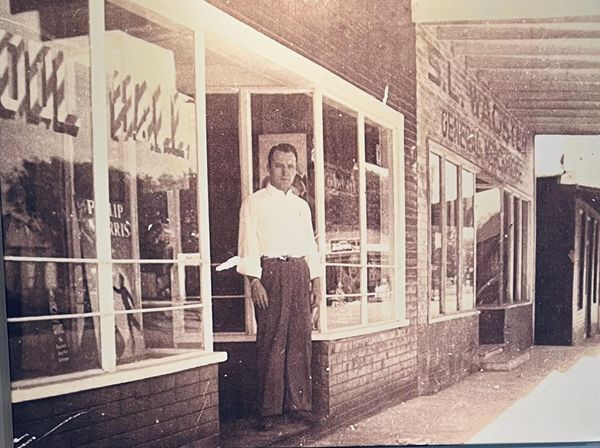

#tbt Mrs. Margaret “Pog” Childers of Cooter recently identified several Cooter pictures for PCHS. Here is the Cooter Pool Hall in the 1940s. It was located on Main Street, as most businesses were, and was operated by Shorty Hunt, who is shown here.


#tbt The oldest building in Caruthersville, the Exchange Building, at the corner of Ward Avenue and West 3rd Street, was dedicated to the Crysler family for their generous donation of the building to the city in 2008. Chris Crysler had these two rarely seen photographs in his store archives. Note in the oldest picture, a car is angle-parked on Ward Avenue.

#tbt J. A. “Peck” Hayden was recently honored by the PCHS on the 2023 Wall of Distinction and everyone is familiar with his store at 12th and Ward Avenue, operated today by Jim Brands.
However, did you know there was an “uptown” Hayden’s Drug Store, run by Peck’s brother, Bill? It opened in 1939 at 418 Ward Avenue and, after Bill’s untimely death on election day in 1948 while waiting in line to vote for Harry S Truman, family members, especially his daughter Elaine Hayden Tillman operated the store until it could be sold.
The store later became Marvin Collins’ drug store and operated for many years.
The river hit an all-time low this past week. Here is the history: Low Water Records for Mississippi River at Caruthersville
(1) -2.64 ft on 10/10/2023
(2) -1.82 ft on 10/16/2022
(3) -0.82 ft on 08/30/2012
(4) -0.70 ft on 01/07/1940
(6) -0.60 ft on 08/23/1936
(7) -0.10 ft on 10/15/1988
(8) -0.05 ft on 08/29/2006
(9) -0.02 ft on 01/15/2001
(10) 0.10 ft on 12/16/1937
(11) 0.37 ft on 09/12/2000
(12) 0.40 ft on 01/23/1956
(13) 0.74 ft on 08/09/2005
(14) 0.80 ft on 01/01/1964
(15) 0.81 ft on 10/07/2007
(16) 0.90 ft on 12/31/1963
(17) 1.10 ft on 11/20/1953
(18) 1.10 ft on 08/14/1941
(19) 1.30 ft on 11/16/1930
(20) 1.40 ft on 10/04/1948
(21) 1.50 ft on 10/21/1935
(22) 1.50 ft on 10/17/1931
(23) 1.50 ft on 09/08/1934
(24) 1.80 ft on 10/20/1947
(25) 1.80 ft on 09/17/1954
(26) 1.80 ft on 09/29/1999

#tbt On September 23, 1920, the Democrat-Argus posted an article about the new school at Bragg City. (In this picture it is called the “original building”, though two other small buildings came before this one.)
“The City of Bragg City had the honor of dedicating the best and most modern school building in Pemiscot County last Tuesday, a substantial two-story brick, which is the third school building the town has had in its comparative short existence of only 10 years.” It was built with a bond issue of $25,000.
The article continued: “The progress of Bragg City in its school work is but in line with its development along other lines, and it is hard for not not familiar with the facts to realize what has been accomplished in a few years. It is doubtful that the history of the country an instance can be found of such rapid development in a community whose future is founded on agriculture alone.”
In the mid-1960s, Bragg City school patrons approved a proposal to annex Bragg City School DistrictC-9 to Kennett School District No. 39. The vote was 182-60.
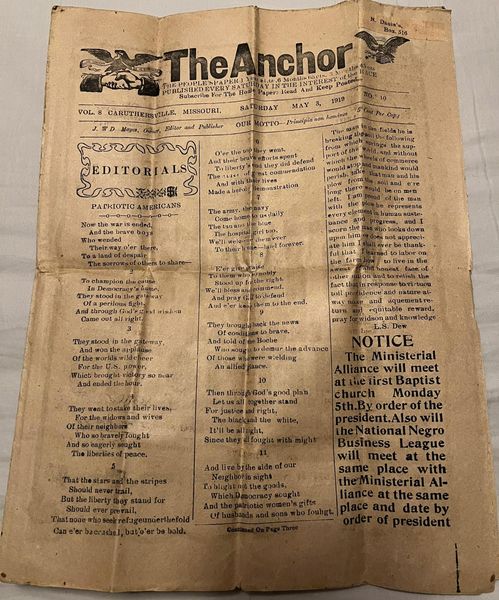




#tbt “The Anchor” was an early black-owned newspaper published in Caruthersville by Rev. J.W.D. Mayes. It was advertised as the only race newspaper between St. Louis and Memphis at the time.
Reverend Mayes was a veteran of the Spanish-American war and was pastor of the local C.M.E. Church, along with being a prominent figure in the local black community. The typesetting and printing of “The Anchor” was handled largely by his three children, who were teenagers and younger.
Publishing of “The Anchor” began around 1912 in New Madrid Mo., and continued there until operations were moved to Caruthersville in mid 1918. Printing here continued for at least four more years, with the last mention being found in 1922.
Very little is known about this newspaper venture as extremely few copies have survived. Information online is almost exclusively limited to mentions in other local newspapers of the day.
Found in a July 1921 issue is an article titled “The Anchor and what it stands for”, which gives insight to the mission of this newspaper. It goes on to state that The Anchor was established a little more than nine years ago and has grown steadily ever since. Today it still sticks to its first and one great principle, the uplift of the whole people. The Anchor has no axe to grind, but will always fight for its convictions, now as it has in the past. Politically, it is strictly a republican sheet, and will at all times defend the republican cause, and will not deviate or extirpate one single jot or title of the great and noble principles or doctrine of this great party.
P.C.H.S would like to thank Mr. Travis Meador for his generous donation of this exceedingly rare newspaper to our archives.

#tbt This is a rare photo from the 1950s, looking west from the First State Bank area. (You can see a corner of the building at the right of the photo.) The Majestic Cafe, shown in the picture, had moved across the street from the hotel of the same name. Roberts Lane, on the street sign, was a short-lived designation leading back to the stately Roberts Home. This road was approximately where the road running beside Quality Cleaners is today.

#tbt Tyler, MO – H. M. Bauer’s General Store on July 10, 1917

#tbt Clay Richardson recently received a book about Caruthersville and inside was this photo of four trophy-winners. Looks like they had a good day of horseshoes. Anyone have any ideas as to the identity of any of these guys or when the photo might have been taken?

#tbt This street scene in Steele is from around 1905 or 1906. Any ideas where this photo was taken? The sign is difficult to read.

#tbt The Budweiser Clydesdales were a celebrated feature of the Caruthersville Centennial parade in 1957. This is pictured as they turned the corner from Ward onto Third Street (in front of the First State Bank and Buchanan’s Furniture, today an insurance agency).


#tbt The very first Cotton Blossom Queen and attendants from 1950 make a pretty picture. Doris Jean Reichert was Queen and the attendants (from left) are Anna Grace Coker, Jimmie Rose Medlin, Helen Jo Hinchey and Norma Jean Bennett. The Cotton Blossom yearbook was not published after the early years (1917-1923) because of the Great Depression and World War II. It resumed being published in 1950 with a pageant that continues to this day.

#tbt This parade from the 1930s shows the Caruthersville Junior Band. It also illustrates the vibrant spirit of downtown Caruthersville at that time. Another item of note is the angle-parking in front of what was the Neifind building, formerly the J.C. Penney store, which opened in the spring of 1940. As you can see at the top of the building, it housed the Wright Bros. Store, with proprietor Gordon Wright, who later had Wright’s Home Furnishings in the 300 block of Ward Avenue until the 1990s.

#tbt For a change of pace, this week we feature a real #tbt of the season. These Letters to Santa were published in the December 24, 1908 issue of the Pemiscot Argus. They can help you notice how much Letters to Santa have changed in almost 100 years and see how the language and their ability to use it has changed.

#tbt From the December 27, 1945 issue of the Caruthersville Journal is an advertisement from the time that Caruthersville actually had two Kroger stores, a little over a block apart. It later moved to its 5th and Walker location, and even later to the lot where the Pemiscot County Justice Center sits today.
